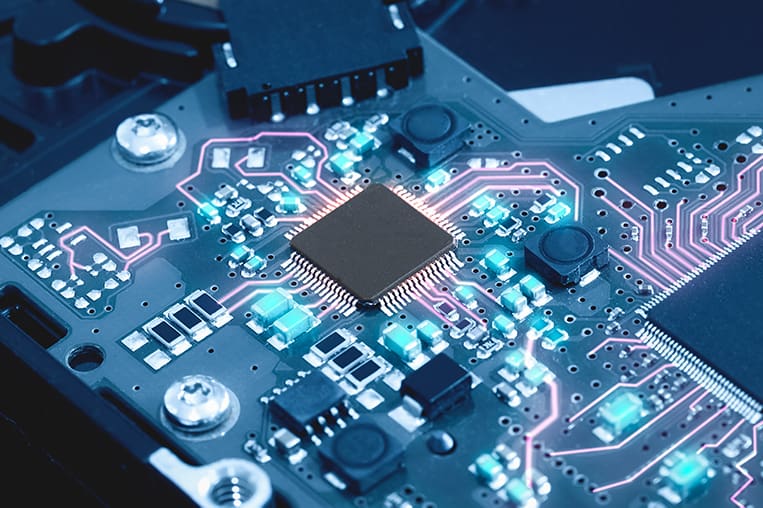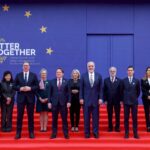The extreme concentration around Nvidia and TSMC in the design and production of semiconductors for AI raises concerns and sparks envy among Big Tech companies, which are highly dependent in this respect. Despite government support, catching up will remain a long-term challenge.
The explosion in artificial intelligence rests on two pillars of a different nature: on the one hand, the development of giant GPT-style large language models and, on the other, phenomenal computing power with dedicated processors. These are designed in particular by the ubiquitous giant Nvidia, and manufactured by a tight-knit handful of players, with Taiwan’s TSMC in particular. AI models and semiconductors require huge investments and cutting-edge skills. However, these two worlds cooperate closely, yet with very different requirements.
In terms of model development, US digital giants such as Microsoft, Meta and Google have all the technological, economic and political resources they need to dominate the sector, both internally and through takeovers and partnerships. This last aspect even enables them to harness the diversification seen with the explosion of open source, i.e. models that are freely distributed and reusable by all. Although open source enables an entire AI ecosystem to exist, it is hardly to be seen as a David versus Goliath situation, as the giants themselves are heavily invested in it. Meta’s LLaMa language models, for example, are open source. In addition, the financial clout of Big Tech is such that independent players are falling into its orbit one after the other. French start-up Mistral recently announced that it was joining Microsoft, entrusting it with the distribution of its most advanced model, which will therefore be closed. The giants thus have ample means to keep a firm grip on model development.
Behind this dominance, the importance of the processors that enable the formation of these AI models should not be underestimated. In fact, they are the lifeblood of today’s technological war, and are in the hands of industrial giants of a different kind. The entire AI scene remains ultra-dependent on an incredibly concentrated chain of semiconductor design and production, centered around Nvidia and TSMC.
A booming demand for AI-dedicated semiconductors, and very few suppliers
For Big Tech, self-sufficiency in semiconductors remains a challenge difficult to tackle. After decades of investment, Nvidia has a virtual monopoly on the design of AI-dedicated semiconductors. Last year, the US company designed 80% of this type of semiconductors worldwide.
Once they have been designed, Nvidia subcontracts their manufacture to Taiwan’s TSMC, one of only ten companies capable of producing them worldwide. Nvidia is said to be « fabless ». In this industry, the manufacture of a semiconductor requires a production line with its own characteristics (manufacturing equipment, testing and packaging). These new production lines are extremely expensive. A brand-new plant (or foundry in industry terminology) requires between $15 and $20 billion and a minimum of two years to build. Very few economic players are able to invest these staggering sums and overcome the entry barrier to the foundry market (« Fabs »).
Governments embrace the issue in the name of technological sovereignty
Despite the enormity of the investments involved, some players are entering or re-entering this market, such as Intel and Japan’s Rapidus. Manufacturers already in the race, such as TSMC and South Korea’s Samsung, are continuing to invest in order to maintain their market share. Following the end of covid-19 and a shortage of semiconductors, some governments decided to boost their financial support for the sector. « Chip Acts » were introduced to increase national semiconductor manufacturing capacity, strengthen economic security and guarantee supplies for military use, even in the event of a crisis. These include the United States, with the Chips and Science Act ($39 billion in 2022), the European Union, with the Chip Act ($43 billion in 2023), Japan, with the creation of the Rapidus conglomerate and a support plan ($100 billion for Rapidus and the new TSMC plants over 2023-2027), China, with the launch in 2023 of phase 3 of the Chinese government’s semiconductor guarantee fund ($46 billion for the 2023-2027 period), and South Korea, with a $7.3 billion government plan. In the US, the knock-on effect of public subsidies in the sector is notable. The $39 billion Chips and Science Act encouraged a $200 billion wave of private investment by American and foreign companies on American soil.
New entrants and a new scale of funding
Until new factories produce more chips, supply will be unable to keep pace with global demand for AI chips. Hence a significant rise in prices. A GPU from Nvidia (H100) can cost up to $40,000 a unit. Its availability is limited because, even with increased production volume, the company is still not meeting market needs. Some users and buyers of Nvidia chips are concerned about dependence on a single supplier. This is the case of Sam Altman, OpenAI’s CEO, as the lack of dedicated AI chips is likely to hamper the development of his own company. Why not try to create his own industrial resources to correct this supply-demand imbalance? This is the logic of any new entrant in a fast-growing sector. Sam Altman has been meeting with manufacturers and investment funds for several months. In his first estimates, he mentioned an (extravagant) $7,000 billion investment drive to build a new chapter in the semiconductor industry. The project is still underway. And Altman is not alone. Initiatives are flourishing. Apple is working with TSMC to manufacture AI chips. Masasyoshi Son, head of the Japanese group SoftBank, wants to transform his group into an AI powerhouse. His latest project is to enable his ARM subsidiary to create a new AI chip division. A prototype will be tested in spring 2025, and mass production should start in autumn 2025. For its part, Nvidia is maintaining its technological lead in an accelerating market. According to Precedence Research of Canada, the global market is set to reach $100 billion in 2029 and $200 billion in 2032.
This scarcity of a new kind is prompting digital giants to enter the market, but in different ways. In the face of these ambitions, Nvidia continues tirelessly to position itself to keep improving, and in particular to outperform what the giants are likely to be able to do when it comes to designing processors dedicated to AI. Digital giants find themselves caught in an industrial stranglehold that will be difficult to overcome. The horizon of balanced global competition, in which all the major economic zones would secure supply and some level of sovereignty remains even more distant and uncertain. The ultra-concentration of semiconductors dedicated to AI points to a very real risk of industrial resilience for the entire chain, right through to end-users. In this respect, diversification is a major political challenge.
By Rémi Bourgeot, economist and engineer, Associate Research Fellow at IRIS, and Estelle Prin, Founder of the Semiconductors Observatory
Find out more about the Observatoire des semi-conducteurs.
Source: French Institute for International and Strategic Affairs (IRIS)







